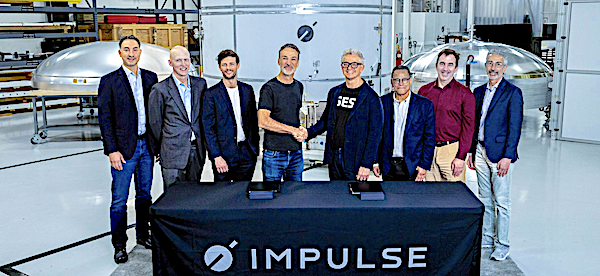
Impulse Space, the in-space mobility leader, and SES, a global content and connectivity provider, today announced a multi-launch agreement to use Impulse’s Helios kick stage to shorten the time required for the selected SES’s satellites to reach their final orbital position whether on geostationary (GEO) or Medium Earth Orbit (MEO), by transporting the satellites from Low Earth Orbit (LEO) directly to high-energy orbits in hours.
The first mission, currently planned for 2027, will feature a dedicated deployment from a medium-lift launcher in LEO, followed by Helios transferring the 4-ton-class payload directly to GEO within eight hours of launch. The agreement provides opportunity for additional missions, allowing SES to rapidly and responsively launch satellites to their selected orbit on demand.

Traditionally, satellite operators wanting to launch their satellites to MEO or GEO orbits have had to choose between costly and low-supply heavy-lift rocket launches or slow, multi-month transfers using electric propulsion. Impulse’s kick stage, Helios, is designed to rapidly deliver payloads from LEO directly to these high-energy orbits in hours, transforming industry dynamics.
“At SES, we are firm believers that co-development and collaboration with our partners will help the space industry to evolve and quicken the pace of innovation,” said Adel Al-Saleh, CEO of SES. “Today, we’re not only partnering with Impulse to bring our satellites faster to orbit, but this will also allow us to extend their lifetime and accelerate service delivery to our customers. We’re proud to become Helios’ first dedicated commercial mission.”
Helios’ responsive capabilities and powerful engine enable mission operators to design, and price, satellites based on their specific operational orbit. This paradigm shift can simplify mission planning and decrease satellite mass, resulting in lower overall mission costs, while improving operational timelines.
“We believe MEO and GEO play a critical role in the space economy, but operators today face the challenges of slow, expensive, and inflexible access to these essential orbits,” said Tom Mueller, founder and CEO of Impulse Space. “Helios changes that — it’s built to move large payloads to high-energy orbits quickly and reliably. SES has a long history of embracing innovation and pushing our industry forward, and we’re proud they’ve chosen Helios to support the next phase of their deployment strategy.”
This marks the first commercial contract for a dedicated Helios mission where a single, 4-ton-class payload will fully leverage the vehicle’s performance capabilities for direct transport to GEO.
